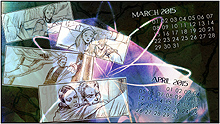



IMAGE |
WALLPAPER |
FAN ART |
FAN FICTION |
Rush by Love and Rock Music. (TCW) The first half of "Destroy Malevolence," as Anakin and Padmé make their way towards each other. |
P/A SITE
|
|
CALENDAR
|
 |

ESSAYS & DISCUSSION
-------------------------------------------
Star-Crossed
by Paul F. McDonald
Published on Suite101.com July 30, 2002
------------------------------
Attack of the Clones is many things to many people. For some, it is a history lesson revealing a lot of the backstory that was spoken of but never shown in the original trilogy. For others, it is a detective story with Obi-Wan Kenobi hot on the trail of Jango Fett, slowly but surely uncovering a plot to take over the Republic. For others still, it is just a good action film. It is all those things, but it is also something of a first - the Star Wars version of an epithalamion. From this perspective, it is essentially a galactic love poem featuring the forbidden romance of Anakin Skywalker and Padmé Amidala, and as such, it does a good job of weaving allusions to other mythic tales that likewise confront such time-honored themes. Some of them end in tragedy, others don't, but all are epic tales of love involving gods and mortals and other tempestuous pairings. Many give rise to all sorts of trials, trips to the underworld, and even deaths and resurrections. Most of the ones here were taken from the Latin poet Ovid, who recorded many of the Greek and Roman stories that have been passed down through the ages.
Whether the story be ancient or modern, there is always something that evokes the compatibility of the lovers, as they each have to have something that the other lacks. This is as true in Attack of the Clones as it is in Roman myths. Anakin is a Jedi Padawan who is being brought up by his master Obi-Wan, and though there is a great respect and friendship there, the relationship can be a bit strained at times. Having left his mother behind on Tatooine, Anakin has been without a prominent female figure in his life for ten years. Padmé brings such a sensibility with her, as well as all the nurturing and acceptance that comes with it. For her part, she has been consumed by her political career, and has given very little time to think about her own needs and desires. Anakin brings a certain amount of fun and mischievousness into her life, as well as the possibility of a family.
Vertumnus and Pomona are two mythic characters that likewise are at odds with one another to begin with. Pomona is a wood nymph who loves the orchards that she lives in more than any of her possible mates, and so she rejects suitor after suitor. Vertumnus is half-immortal, but even he cannot resist her. He falls in love with her the moment he sees her, but he is rejected like all the rest. Venus the goddess of love has to intervene, and she ordains that the two be married. Though they cannot see it, they complement each other perfectly, and she gives them the example of the trellis that holds up the grapes so that they will not be trampled underfoot. Without the trellis, the grapes would be useless, and without the grapes, the trellis would be as well. So is it with all true lovers.
Yet in other stories, lovers do not find their way to each other so easily. Sometimes, they have to endure all kinds of hardships and even defy death. The separation many of them face often only serves to bring them closer together. For Anakin and Padmé, the journey is never easy. In fact, the two young lovers initially refuse the call, feeling that even if they opened their private hearts, their public lives would be destroyed. They are held apart by a societal wall of Thou Shalt Nots, by institutions both secular and religious, and do not come together until the end.
So is it with the story of two beautiful youths named Pyramus and Thisbe who live in the city of Babylon. They are both madly in love with one another, but a literal wall separating their adjoining houses keeps them apart. All they can do is whisper to each other through a tiny hole. They eventually decide to run away together, and meet under a mulberry tree by a well-known tomb. Fate has other ideas, however, and when Pyramus makes his way there, he sees a lioness tearing apart a piece of Thisbe's robe. The girl has managed to get away, but he doesn't know that, so he kills himself. Thisbe eventually comes back, finds his body, and does the same. Perhaps the piece of cloth that the nexu in the arena tears off Padmé is an allusion to this. At any rate, it is commonly believed that the gods allow Pyramus and Thisbe to be reunited in eternity, and hopefully Anakin and Padmé will find each other once again in the Force.
There are also many trips to the underworld in ancient myths, where lovers have to go in search for one another. One of the more well-known quests involves Orpheus the musician, whose wife Eurydice has been taken to Hades. His music can charm anyone, mortal and immortal alike, and with it he makes his way past all the guardians of the underworld. He is finally allowed to take his wife up to the land of the living, but only if he doesn't look back at her before they make it to the surface. The two have almost made it up, but Orpheus is overcome with desire and anxiety and has to look back. When he does, Eurydice vanishes.
Like Orpheus, everyone knows that Anakin has a very hard time letting go. It is interesting, but his mother Shmi tells him as a boy when he leaves her "Don't look back." This could be a reference to the Orpheus story, because when Anakin does return for her, she winds up dying in his arms. It is quite possible that the situation will repeat itself for his wife Padmé in Episode Three, before his own fall to the dark side.
Of course, the underworld quest is not limited to men. In Egyptian mythology, the goddess Isis goes after her slain husband Osiris who is tricked and entombed by his evil brother Set. It is she who finds his sarcophagus and uses magic incantations to bring her lover back to life. Like the good, handsome young god Osiris, Anakin is entombed when he becomes Darth Vader, his suit of body armor not unlike a sarcophagus. It will be fascinating to see whether or not Padmé will go on a journey to the underworld to try to resurrect him in Episode Three.
George Lucas has said that the two trilogies are meant to mirror one another, and Princess Leia does successfully travel to the underworld of Jabba the Hutt's palace in Return of the Jedi to resurrect her lover Han Solo, who has been frozen in carbonite. Her journey echoes the Sumerian story of Ishtar, who travels to the land of the dead to save her husband Tammuz. At each gate she comes to she has to shed an article of clothing, and this is echoed by Princess Leia being forced to wear the metal gold bikini.
Whatever tragedy unfolds for the two in the end, Anakin and Padmé do successfully overcome the necessary trials and marry one another in Attack of the Clones. The wedding takes place in the Lake Country and is presided over by a Naboo holy man. The two are joined by Anakin taking Padmé's hand, something that is frequently done in Vedic weddings in India. It is quite fitting that R2-D2 and C-3PO are the witnesses to the event, because as Lucas has noted, the entire original trilogy is from their point of view. They have been the witnesses for the audience since the beginning. This becomes quite sad when one realizes that the droids' memories are going to be erased before Episode Four, thus eradicating any evidence of the marriage in a galaxy in which Padmé is probably dead and Anakin has turned to the dark side.
-
<<back to essays & discussion